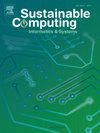占用预测:利用 WiFi 系统日志数据对静态和 MOTIF 时间序列特征进行比较研究
IF 3.8
3区 计算机科学
Q1 COMPUTER SCIENCE, HARDWARE & ARCHITECTURE
引用次数: 0
摘要
占用率预测一直是持续研究的主题,它采用各种方法和数据源来提高占用率预测的准确性和建筑物的能源效率。精确的占用预测对于优化能源使用、确保居住舒适度和加强楼宇管理至关重要。随着对智能楼宇管理系统的需求日益增长,稳健而准确的占用预测模型变得越来越重要。本研究旨在利用来自三个不同数据集的 WiFi 系统日志文件预测楼宇占用情况:一个来自马萨诸塞大学达特茅斯分校的开源数据集,一个来自底特律梅西大学牙科学院的本地收集的新数据集,以及一个来自加利福尼亚州伯克利办公楼的数据集。从数据集中提取了两种类型的特征,即静态特征和 MOTIF 时间序列特征,以处理和比较它们在占用率预测中的性能。得出的结论是,这种分析最好按学期进行。在接下来的步骤中,应用了随机森林和 LightGBM 等多重回归算法,以及包括堆叠和混合在内的高级集合技术来评估模型。在所有数据集的静态特征方面,堆叠回归显示出最佳结果。第一个数据集的判定系数(R2)为 0.9540,第二个数据集为 0.9482,第三个数据集为 0.9977。然而,对于 MOTIF 特征,最佳算法取决于数据集。在第一个数据集中,所有算法的表现相似,R2 为 0.956。相比之下,LightGBM 和堆叠回归算法在第二个数据集中的表现要好于其他算法,但由于特定数据集的差异,R2 较低,仅为 0.531。在最后一个数据集中,堆叠回归再次取得了最佳结果,R2 为 0.9967。本文章由计算机程序翻译,如有差异,请以英文原文为准。
Occupancy prediction: A comparative study of static and MOTIF time series features using WiFi Syslog data
Occupancy prediction has been the subject of ongoing research, employing various methods and data sources to improve occupancy prediction accuracy and energy efficiency in buildings. Precise occupancy prediction is crucial for optimizing energy usage, ensuring occupant comfort, and enhancing building management. With the increasing demand for intelligent building management systems, robust and accurate occupancy prediction models are becoming more critical. This study aims to predict building occupancy using WiFi Syslog files from three different datasets: an open-source dataset from the University of Massachusetts Dartmouth, a new locally collected dataset from the dental school at the University of Detroit Mercy, and finally, a dataset from an office building in Berkeley, California. Two types of features, static features, and MOTIF time series features, were extracted from the datasets to process and compare their performance in occupancy prediction.
The first step of the proposed framework consisted of selecting the most suitable time range to compare occupancy prediction models between different datasets. It was concluded that this analysis was best conducted semester by semester. Multiple regression algorithms, such as random forest and LightGBM, were applied in the following step, along with advanced ensemble techniques, including stacking and blending, to assess the model. The stacking regression showed the best results for static features across all datasets. It achieved a Coefficient of Determination () of 0.9540 in the first dataset, 0.9482 in the second, and 0.9977 in the third. For MOTIF features, however, the best algorithm depended on the dataset. All algorithms performed similarly in the first dataset, with of 0.956. In contrast, LightGBM and the Stacking Regressor had better results than the others in the second dataset, with a low of 0.531 due to dataset-specific differences. The stacking regression once again delivered the best results in the last dataset with an of 0.9967.
求助全文
通过发布文献求助,成功后即可免费获取论文全文。
去求助
来源期刊

Sustainable Computing-Informatics & Systems
COMPUTER SCIENCE, HARDWARE & ARCHITECTUREC-COMPUTER SCIENCE, INFORMATION SYSTEMS
CiteScore
10.70
自引率
4.40%
发文量
142
期刊介绍:
Sustainable computing is a rapidly expanding research area spanning the fields of computer science and engineering, electrical engineering as well as other engineering disciplines. The aim of Sustainable Computing: Informatics and Systems (SUSCOM) is to publish the myriad research findings related to energy-aware and thermal-aware management of computing resource. Equally important is a spectrum of related research issues such as applications of computing that can have ecological and societal impacts. SUSCOM publishes original and timely research papers and survey articles in current areas of power, energy, temperature, and environment related research areas of current importance to readers. SUSCOM has an editorial board comprising prominent researchers from around the world and selects competitively evaluated peer-reviewed papers.
 求助内容:
求助内容: 应助结果提醒方式:
应助结果提醒方式:


